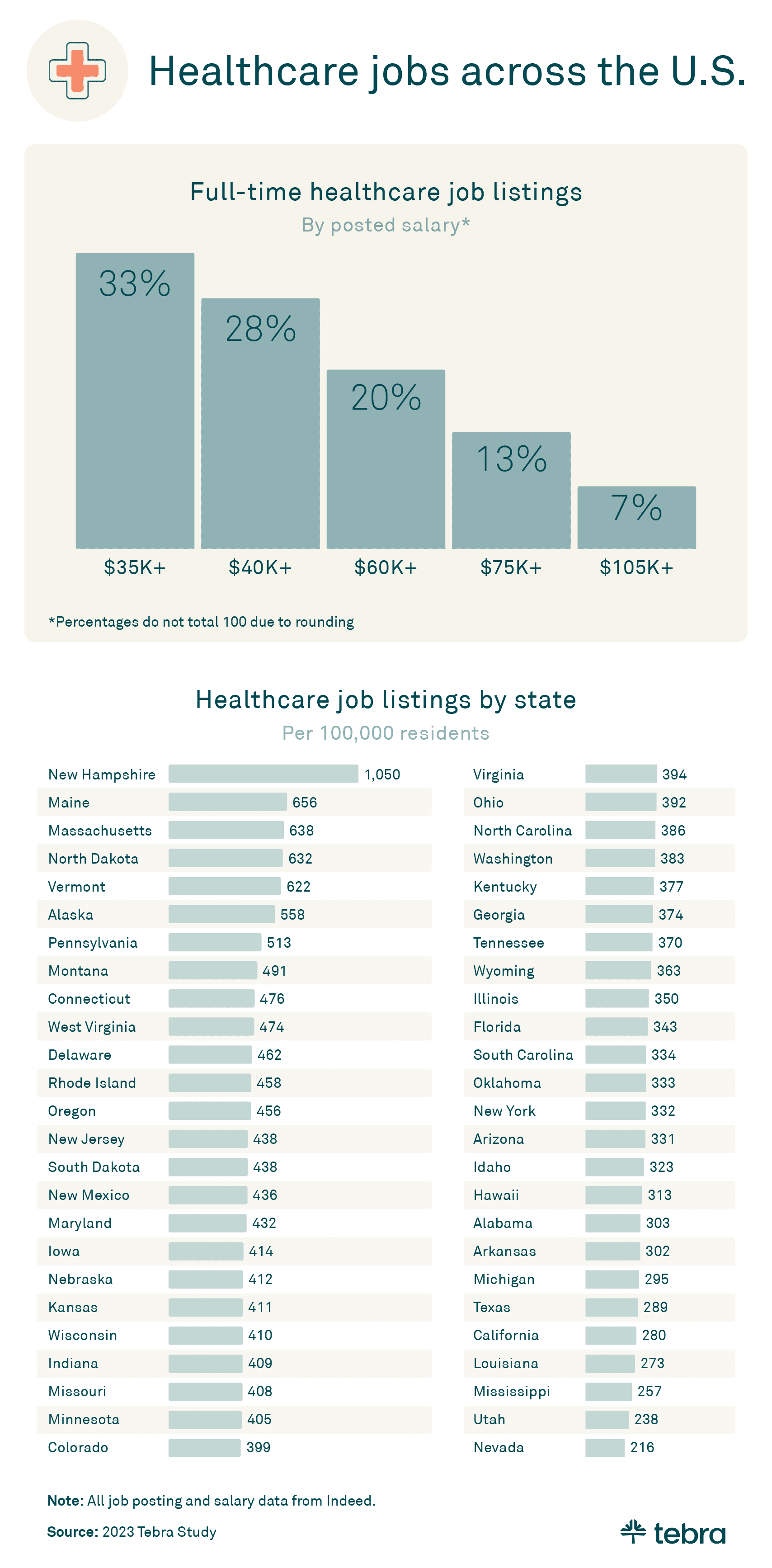A deep dive into healthcare job vacancies across the U.S.
The most recent Kaiser Permanente strikes highlight the employment issues plaguing the American healthcare industry, including salary disparities and staffing shortages. To better understand the current employment climate, Tebra analyzed thousands of healthcare job postings on Indeed. Read on to find out the average salary for healthcare professionals and which states have the highest worker demand.
Key takeaways
- New Hampshire has the most job postings for healthcare per capita, followed by Maine and Massachusetts.
- Nevada has the fewest job postings for healthcare per capita, followed by Utah and Mississippi.
- 61% of healthcare job postings offer salaries below $60,000.
Job hunting in healthcare
Job hunting can be difficult within any field, but finding a job in healthcare has unique challenges, especially amid industry strikes. Let’s look at which states have the most available job postings and how much healthcare workers can expect to make.

Surprisingly, one-third of full-time healthcare job postings paid between $35,000 to $40,000. Furthermore, 61% of postings offered salaries less than $60,000. These salaries seem inadequate when considering the long shift hours, heavy workload, and demanding responsibilities of most healthcare workers. For almost half of U.S. states, a salary below $60,000 would not make up a single person’s living wage. Indeed, the Kaiser strikes demonstrate the urgency for raising healthcare worker salaries and addressing staff shortages to lighten workloads.
The number of job listings in each state reflects the widespread staffing crisis in healthcare. New Hampshire’s statewide staffing shortage was evidenced by its 1,050 healthcare job postings per 100,000 residents. Following New Hampshire, Maine, Massachusetts, North Dakota, and Vermont had over 600 job openings per 100,000 residents. In contrast, Nevada had just 216 job postings per 100,000 residents, followed by Utah and Mississippi with 238 and 257 listings, respectively. With an average 74% of inpatient and 69% of ICU hospital beds filled, it is imperative for states to fill open healthcare positions in order to offer patients high-quality care.
Understaffed and underpaid
The Kaiser strikes demonstrate ongoing problems within the healthcare industry, namely, staffing shortages and pay disparities. If the industry wants to avoid further strikes, it will need to increase pay for healthcare professionals to reflect their demanding schedules and responsibilities. Furthermore, hospitals must address staffing shortages as quickly as possible to prevent worker burnout and turnover. If the healthcare industry prioritizes its frontline workers, it can avoid more strikes and help patients get the care they need.
About the Kaiser Permanente Strike
More than 75,000 Kaiser Permanente employees walked off the job onOctober 4, initiating the largest health care worker strike in U.S. history, union officials said.
Kaiser and the Coalition of Kaiser Permanente Unions were unable to reach a deal during a marathon bargaining session in San Francisco on October 15.
Those who walked out include nursing assistants, house keepers, X-ray technicians, phlebotomists, pharmacists, optometrists and other support staff.
After the historic strike, Kaiser Permanente workers won a 21% raise over 4 years.
Methodology
Tebra analyzed thousands of nationwide healthcare job postings on Indeed to examine the salary breakdown of jobs in the healthcare industry and determine which states have the most job postings per capita.
About Tebra
Tebra is enhancing healthcare delivery with its cutting-edge solutions for independent practices. We bridge technology and care, ensuring every patient has access to modernized, exceptional healthcare services. With Tebra, the future of healthcare is not just advanced but personalized.
Fair use statement
We encourage the sharing of our findings to spread knowledge and insights. If you wish to use this information, please do so for non-commercial purposes only and provide a link back to this page to attribute the source appropriately.
Download your free resource now
Access it instantly — just complete the form







